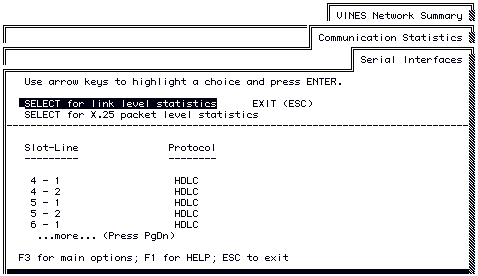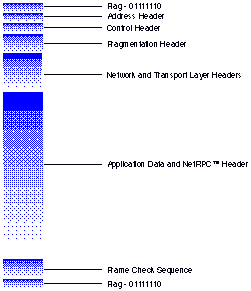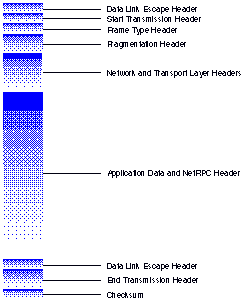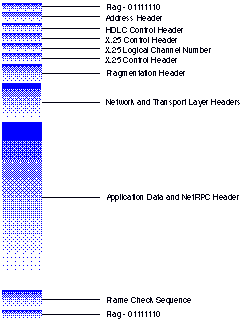Chapter 5 - Serial Line Interface Information and Statistics
This chapter describes configuration information and statistics that VNSM displays for a VINES server's serial line interfaces. A serial line interface is the point at which a server accesses a serial line, such as an HDLC serial line.
This chapter discusses the following topics:

Accessing serial line interface information and statistics. 
Viewing serial line statistics, including link-level statistics and X.25 packet-level statistics.
Accessing Serial Line Interface Information and Statistics
To access network interface configuration information and statistics, choose SHOW communications statistics from the VINES Network Summary menu. The Communication Statistics menu appears.

This menu displays the LAN cards installed in the server, summary statistics for each card, and the amount of time, since the last reboot of the server, that VNSM statistics have been accumulating. The menu also lets you perform the following actions:

Select LAN cards to view detailed statistics for VINES servers. See Chapter 4 for more information. 
View protocol family statistics. See chapters 10, 11, 12, and 13 for more information. 
View configuration information and statistics on communication resource usage. See Chapter 6 for more information.
Viewing Serial Line Statistics
Serial Line statistics show line activity information for all active lines on all of the serial communications cards installed in the server.
If a line is assigned to a server-to-server communications interface, such as HDLC, asynchronous, or X.25, some of the information on this screen is also available at the Interface Details screen for that interface.
In addition to the information on server-to-server interfaces, the Serial Line Statistics screen provides information on the protocols used by other VINES serial communications options, such as 3270/SNA, and Asynchronous Terminal Emulation.
To view serial line statistics, choose the option SHOW serial line statistics from the Communication Statistics menu. The Serial Interfaces menu appears.

The Serial Interfaces menu displays all the serial lines available on the server. The menu displays the fields of information described in the following sections.
Slot-Line
The slot number of the line's serial communications card and the number of the line's port on the card. For example, 5-2 indicates line number 2 (an X.25 line) on the serial communications card in slot 5.
Protocol
The protocol that was specified when the line was assigned. Protocol types are as follows:

HDLC - (High-Level Data Link Control). Used for synchronous server-to-server communications. 
ASYNC dial-in - Used for block asynchronous, PC Dial-in communications. This protocol supports the transmission of asynchronous characters in blocks. See the VINES PC Dial-In Option Guide for more information. 
ASYNC - Used for block asynchronous server-to-server communications. This protocol supports the transmission of asynchronous characters in blocks. 
ATE - Used for asynchronous terminal emulation sessions with a host computer. The protocol is a traditional character-based protocol (Start Bit-Character-Stop Bit). See the Banyan Asynchronous Terminal Emulation Guide for more information. 
X.25 - Used for server-to-server communications through a Public Data Network (PDN) or directly over a serial line. Statistics are provided for X.25 server-to-server communications only. Statistics do not reflect X.29 host communications or X.29 Dial-in activity on the line. 
SDLC1 - Used for 3270/SNA communication with IBM (or compatible) host computers. SDLC indicates that the line supports the Synchronous Data Link Control (SDLC) protocol. The "1" in "SDLC1" indicates that the line is connected to a PersystTM card. See the VINES 3270/SNA Option Guide for more information. 
SDLC2 - The same as SDLC1, except that the line is connected to an ICATM, ICAmCTM or ICAplusTM card. 
TTY - Indicates that either the line connects an asynchronous terminal to the server or the line connects a printer to the server. TTY stands for Teletypewriter protocol, which is a simple, asynchronous telecommunications protocol that has been used for many years.
Server consoles can be connected to the server through a modem and a TTY line.
Understanding Link-level and X.25 Packet-level Statistics
The Serial Interfaces menu allows you to view link-level statistics for all lines and for X.25 lines, to view X.25 packet-level statistics. Link-level statistics provide you with performance information on data link layer protocol activity. VNSM keeps track of how the server processes frames that are sent and received over serial lines. The formats of frames vary, depending on the protocol. VINES, AppleTalk, or TCP/IP traffic can be in the frames.
Figures 5-3 and 5-4 show some sample frames that are sent and received over serial lines.


See the VINES Protocol Definition for more information on frame formats.
Packet-level statistics provide you with performance information on activity on the X.25 packet layer. VNSM keeps track of how the server processes X.25 packets that are sent and received over X.25 lines. An X.25 packet is encapsulated within an HDLC frame. VINES, TCP/IP, or AppleTalk data can be in the X.25 packet. Figure 5-5 shows a sample X.25 packet.

The sections that follow describe link-level statistics and packet-level statistics.
To view link-level statistics for a serial line, perform the following steps:
1. Choose SELECT for link level statistics from the Serial Interfaces menu.
2. SELECT the serial line. The Serial Statistics screen appears.
The statistics on this screen are described in the sections that follow. Remember that you can press F10 to request an immediate update while viewing this screen.
Slot
Identifies the slot number of the serial line's communication's card.
Line
Identifies the line number of the serial line on the card.
Total In
The total number of frames received. To identify receive problems, compare this number to the number of receive errors. Receive errors are indicated by the following fields: CRC Errors, Drops, Overruns, and Framing Errors.
Total Out
The total number of frames transmitted. To identify transmit problems, compare this number to the number of transmit errors. Transmit errors are indicated by the following fields: Re-transmits and Underruns.
Re-transmits
The total number of frames retransmitted. If the destination node does not acknowledge the last frame sent within a certain period of time, the communications card resends the frame. A high Re-transmits value can indicate either line noise or a problem with the card's processor.
CRC Errors
The number of Cyclic Redundancy Check (CRC) errors on receive. Any significant value in this field indicates a malfunction. CRC error checking involves a series of calculations. The transmitting node places the results of a CRC calculation in the frame. When the frame is received, the receiving node recalculates the CRC values and compares its results to those received from the sending node. If the values do not match, a request for retransmission is sent to the sending node.
For most connections, errors reported in this column indicate poor line quality, especially when combined with a high retransmission count in the Re-transmits column and a high Drops count. When the Re-transmits field and the CRC errors field have high counts, it indicates that both incoming and outgoing frames are not reaching their destinations, probably due to a problem with the line.
For an SDLC connection, errors reported in this column can indicate that the SDLC connection is bad, usually due to line problems, but sometimes due to a hardware error.
Drops
The number of received frames dropped due to a lack of communications buffers. If these errors persist, consider increasing the server's communication buffer size. See Chapter 15 for information on increasing the server's communication buffer size.
Underruns
The total number of transmitter underrun errors on receive. An underrun error indicates that the transmitter failed to send a frame because the card's processor was too busy.
Overruns
The total number of receiver overrun errors on receive. An overrun error indicates that the receiver only read in part of a frame and stopped because the card's processor was too busy.
Framing errors
The total number of framing errors. A framing error indicates that the card received an incomplete frame. Incomplete frames often indicate line noise.
Viewing X.25 Packet-level Statistics
To view packet-level statistics for an X.25 line, perform the following steps:
1. Choose SELECT for X.25 packet level statistics from the Serial Interfaces menu.
2. Select the X.25 line. The X.25 VCs (virtual circuits) menu appears, displaying the local session numbers of all of the line's active virtual circuits. A local session number is an internal number that internal communication software uses to identify the virtual circuit. It is not the same as the virtual circuit's logical channel number, which the PDN assigns to the X.25 virtual circuit.
3. At the X.25 VCs menu, select a local session number. The X.25 VC Statistics Screen appears.
The X.25 Statistics screen displays detailed statistics for X.25 VCs. The screen shows the server name, and the local session number for each VC.
The following sections describe each field on the screen. Remember that you can press F10 to request an immediate update while viewing this screen.
Total Messages In
The total number of VINES IP packets received on this VC. Depending on the size of the X.25 packets received, more than one X.25 packet can make up a VINES IP packet. Thus, the value in this field will probably be greater than the value in the Packets In field.
Total Messages Out
The total number of VINES IP packets sent on this VC. Depending on the size of the X.25 packets sent, more than one X.25 packet can make up a VINES IP packet. Thus, the value in this field will probably be greater than the value in the Packets Out field.
Input Errors
The total number of input errors.
Output Errors
The total number of output errors.
Packets Out
The total number of X.25 packets transmitted on this VC.
Packets Awaiting ACK
Total X.25 packets transmitted on this VC that are awaiting acknowledgment.
Bytes Out
Total bytes transmitted on this VC.
Bytes Awaiting ACK
Total bytes transmitted on this VC that are awaiting acknowledgment.
Packets In
Total X.25 packets received on this VC.
Bytes In
Total bytes received on this VC.
Resets Out
Number of X.25 reset packets transmitted on this VC.
Resets In
Number of X.25 reset packets received on this VC.
Logical Channel Number
The logical channel number of the X.25 VC. Whereas the local session number is an internal number that internal communication software uses to identify the VC, the logical channel number is the standard, X.25-defined VC identifier that is used by the PDN to identify the VC. This statistic may not appear for some servers because the product revision that they run does not support it.
Remote X121 Address
The DTE address of the remote server on the other end of the VC. Address DTE addresses conform to the CCITT X.121 standard. This statistic may not appear for some servers because the product revision that they run does not support it.